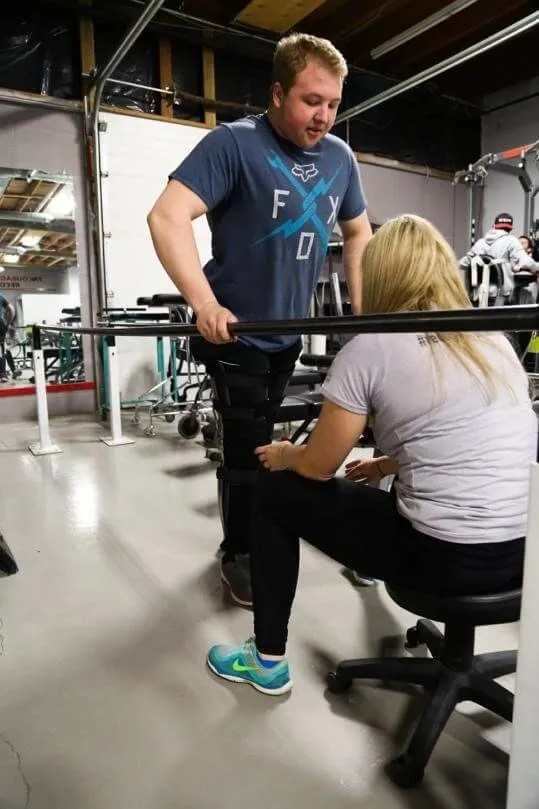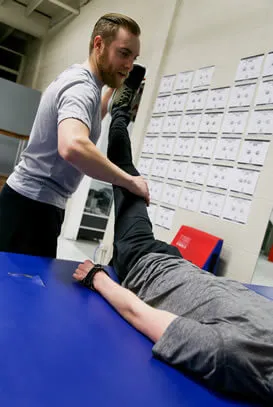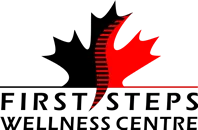Spinal Cord Injury
SCI Rehabilitation

Activity-based therapy (ABT) is composed of interventions that target activation of the neuromuscular system, below the level of the lesion. The goal of ABT is to retrain the nervous system to recover specific motor tasks and functions. Our ABT sessions are based on the principles of neuroplasticity including high intensity, high repetitions and specificity of exercises. FSWC also involves various types of stimulus to help induce neuroplasticity, including functional electrical stimulation, pneumatic resistive/assistive training, and vibration training. In some cases, stimulation is done manually or through the proper application of specialized equipment.
Our clients repeatedly go through the functional exercises to promote the relearning of developmental movement patterns including rolling, sitting, kneeling, standing and walking. Loading weight to the limbs through developmental movement patterns also helps to gradually rebuild muscular endurance and strength.
FSWC customizes programs for clients based on their current level of function as well as the client’s goals. In order to stimulate the nervous system to change and adapt, most of the exercises done here at FSWC will be aimed at restoring function below the level of injury. A minimum of one therapist will accompany each client during their session; sessions are typically 2-4 hours a day, 3-5 days a week. ABT for spinal cord injuries is being applied around the world. In Canada, there are a handful of centers that are beginning to apply these techniques, with FSWC leading the way with over 10 years of experience.
Our SCI Rehab Programs
- LiteGait® body weight supported gait trainer
- FES (functional electrical stimulation) systems
- FES Xcite System
- Power Plate® vibration training
- Keiser® Rack
- Biodex Biosway®
- Total Gym®
- Parallel Bars
- Universal Exercise Unit®
Therapy sessions at FSWC uniquely combine aerobic and strengthening exercises for physical conditioning, with task specific patterning, and developmental movement patterns to promote functional relearning.
Last but not the least, our qualified and educated staff, along with our inspiring clients creates a positive environment that is ideal for recognizing the untapped potential to improve each day.
*Before acceptance to our programs, we require a note from your doctor clearing you to participate in an intensive exercise program, as well as clearance to participate in load bearing activities such as standing (a bone density scan may be needed).
If you are unsure if you are a candidate for our program or if you have further questions please do not hesitate to contact us by email info@fswcregina.ca or by phone 306.522.3792. We would love to hear from you.
The First Steps Method
FSWC believes in intensive activity-based functional recovery in individuals with SCI and other neurological impairments like stroke and multiple sclerosis.

First Steps Wellness Centre (FSWC) is a specialized rehabilitation facility that was established to promote functional recovery in individuals with a spinal cord injury (SCI). Our methods differ from traditional rehabilitation as we focus on promoting functional gains below the level of injury through intensive, activity-based recovery methods. Due to the success our clients with SCI have had, we have made our methods available to individuals with other nervous system impairments such as, but not limited to, stroke, acquired/traumatic brain injuries, Cerebral Palsy and Spina Bifida.
We believe that each individual has a potential to recover lost function, the extent of which can depend on multiple factors: level of injury, ASIA score, complete/incomplete injury, experience with physical activity, and any secondary health factors. We understand that each of these factors can vary from client to client. Each individual with a SCI is different and so are their sessions. We customize each session to put our clients in situations where they will succeed and recognize their potential.
Our methods are research-based and we follow the latest clinical best practices to produce outcomes that increase functional recovery following a SCI. In recent years, there has been an increase in research being completed to understand the mechanisms leading to functional recovery after SCI.
Questions? Contact First Steps Today!

Science Behind Our SCI Methods
The spinal cord is a bundle of nerves that carries sensory, motor and reflex signals between the brain and the body. Injury to the spinal cord may interfere with the nerve conduction leading to sensory and motor impairments. As a result, individuals with a SCI may not be able to perform activities in a way that is otherwise considered normal for that individual. This limitation may impact the individual’s participation in activities of daily living.
The ultimate aim of any physical rehabilitation program for a SCI should be to improve quality of life by increasing function below the level of injury. Conventionally, physical rehabilitation has taken a compensatory approach. The belief that the nervous system is hard wired and irreparable has left the primary goal of conventional therapies to accommodate existing impairments and use assistive devices such as orthotics and wheelchairs to improve participation in day-to-day activities.
The bone mass below the level of lesion decreases rapidly after the first few years of injury and continues to decrease gradually, unless addressed in the early stages following injury. Unloading is an important factor for osteoporosis along with neuronal and hormonal changes after SCI (Jiang et al., 2006). Research has shown there is a transformation from slow twitch fatigue resistant muscle fibers to fast twitch, fast fatiguing muscle fibres. These physiological changes not only affect the functional capacity of the muscles, but also the metabolic functions of the muscles leading to metabolic disorders such as obesity, dyslipidemia and diabetes (Manns et al., 2005). Decrease in bone mass leading to osteoporosis following a SCI is a common complication. Compensatory approach not only discourages individuals with a SCI to use residual function in the affected areas but also further weakens the affected areas below the level of lesion and can lead to secondary complications of SCI.

While the concept of functional recovery is growing in the rehabilitation industry, it is common for our clients at First Steps to see increased function below the level of lesion. In recent years, there has been a shift in the way physical rehabilitation is viewed for individuals with a SCI. Researchers have categorically stated that the field of modern neurorehabilitation no longer aims at compensation for disabilities; rather, it works through a spectrum of therapeutic interventions to gain functional recovery by use of “restorative neurology,” the practice of facilitating neural plasticity (Tansey, 2010). Physical activity-based exercise is one such essential therapeutic intervention. Researchers have provided preliminary evidence to show that the nervous system is not hard-wired but malleable, and that function lost due to a SCI can be recovered.
Frequently Asked Questions
A study conducted at FSWC by students from the Johnson Shoyama Graduate School of Public Policy, University of Regina found that in 12% of our cases, clients have been able to walk again after a spinal cord injury, compared to less than 0.5% of post rehabilitation for those who don’t attend. In addition, they found that 94% of our clients had been able to make functional gains resulting in increased independence and quality of life.
Due to generous support from sponsors, donors, fundraisers and grants, FSWC is able to offer service at a very affordable rate per hour and provide nearly $500,000 worth of therapy equipment. Our fees are lower than any other private neurorehabilitation centre in Canada and most of the US. All fees go directly to operating costs and staff training. Please contact us for more information.
FSWC’s most radical characteristic is the quantity of therapy hours our clients participate in. We operate under the assumption that in order for adaptation to occur, our clients need to train like Olympic level athletes. The amount of time you will spend with one or more therapists at FSWC will be one of the largest differences you will notice, along with the unique methods we use, in comparison to conventional therapy. Since our goal is to restore or create function most of your time at FSWC will be spent working below your level of injury.
We use specially designed activity-based exercise programs to stimulate the body below the level of injury. As well, we have specialized equipment designed specifically for people with a SCI and applied by therapists with a significant amount of experience working with SCI. Scientific research confirms that nerves can regrow, but only if they are stimulated.
Research has shown that the nervous system can regain function even after a severe injury. This is referred to as neuroplasticity and simply means that the central nervous system is not hard-wired but is able to find a way to rebuild itself to some degree even after severe injuries.
94% of FSWC’s clients regain some form of function below their level of injury. These improvements can range from improving the motor function of abdominal and postural muscles that assist with sitting stability, to voluntary contraction of large muscle groups in the arm or legs. The amount of improvement that you gain depends on several variables such as the level and severity of your injury, you current fitness level, years post injury, and the amount of time you spend working on your functional goals.
For example, one of our clients was a complete quadriplegic and has now regained movement in her arms and is able to feed herself without assistance. This is a major improvement in her quality of life.
This depends on the severity of the injury, the age of the person injured, how motivated the client is and many other factors. However, most research indicates that the first six months following an injury is when the majority of changes occur, so time from injury to the beginning of therapy is a factor as well. Typically, improvements will be seen sometime near the end of the third month of therapy assuming that attendance is approximately 10 hours/week.
Yes, the underlying concept of our therapy is that the body will find a way to adapt if it is placed under the appropriate stress. While the physiological mechanisms are still being studied, the results are apparent – if you stimulate the body below the level of injury with exercise, the body will adapt and a level of function will be regained. If not, the muscles and the nerves will atrophy, making functional gains more difficult.
Unfortunately, there is no real way of telling. However, we do know that the sooner the program is started, the younger you are, the more work you put into it and how motivated you are to do the exercises both at our facility and at home, the more progress you will see.
The only real way to participate in our program is to be at one of our facilities. How often you come into the facility and how much work you put in will all contribute to how much progress you ultimately make. We custom-design programs tailored to your specific situation so there are options available for those unable to travel. Please contact us to discuss our home program option.
Yes, while we understand not everyone will be able to commit to full time therapy, this is the best way to see results. We have clients that attend 2-8 hours per week that participate in our maintenance program. Our maintenance clients are still able to make functional gains; however, it takes much longer to produce results. Majority of our maintenance clients attend therapy for the health and wellness benefits of exercise, rather than to produce functional gains.
Highly motivated individuals who have obtained a Bachelor’s degree in Kinesiology and have or are working towards their CSEP-CEP. CSEP-CEP stands for Canadian Society for Exercise Physiology – Clinical Exercise Physiologist.
Our staff is committed to researching and finding new ways to improve the overall health, independence and quality of life of all clients we work with.
Please contact your insurance provider to discuss if they will cover your therapy. We provide exercise therapy, and staff at FSWC hold CSEP-CEP designations. We are willing to provide any paperwork required by your insurance company for participation in our programs.
Yes – please contact us about speaking to people who are currently or who have recently attended our program.


